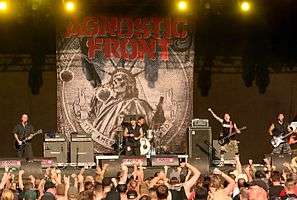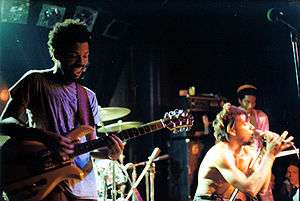Heavy hardcore
| Heavy hardcore | |
|---|---|
| Other names |
|
| Stylistic origins | |
| Cultural origins | Late 1980s, New York City, New York, U.S. |
| Typical instruments | |
| Fusion genres | |
| Regional scenes | |
| |
| Other topics | |
Heavy hardcore (also known as tough guy hardcore, beatdown hardcore, moshcore, and brutal hardcore) is a subgenre of hardcore punk that incorporates more music elements of heavy metal than traditional hardcore punk. Heavy hardcore features aggressive vocals, down-tuned electric guitars, gang vocals, and heavy breakdowns. Heavy hardcore bands tend to often get labelled as simply "hardcore", causing the term "hardcore" to be a vague term because the term "hardcore" also is used as a label on traditional hardcore punk, a genre played by bands like Minor Threat and Bad Brains.
New York hardcore bands such as Agnostic Front, Warzone, Sick of It All, and the Cro-Mags and the thrash metal subgenre crossover thrash paved the way for heavy hardcore. Heavy hardcore emerged in the late 1980s and early 1990s with bands such as Killing Time, Madball, and Sheer Terror. In the mid-to-late 1990s and early 2000s, many other heavy hardcore bands, such as Hatebreed, Bulldoze, Shai Hulud, and Strife, all became prominent heavy hardcore bands. Heavy hardcore bands such as Terror and Death Before Dishonor gained cult followings in the mid-to-late-2000s.
Characteristics

Heavy hardcore (also known as tough guy hardcore, beatdown hardcore, moshcore, and brutal hardcore) is a genre of hardcore punk that features aggressive vocals, down-tuned electric guitars, gang vocals, blast beats, and heavy breakdowns.[1][2][3] More heavy metal-influenced than traditional hardcore punk,[4] heavy hardcore often is heavily influenced by thrash metal music and is sometimes influenced by hip hop music.[1] Breakdowns in heavy hardcore tend to be staccato low-end musical breaks. According to writer Brian J. Kochan, heavy hardcore "embraces the mystique of the gritty and hard working class lives of those in America's big cities".[5] Writer Kevin Warwick of Bandcamp described breakdowns in heavy hardcore as "thick palm-muted rhythmic guitar jogging alongside the clicking, pinpointed thrum of a double-kick pedal and quarter-notes on the crash".[6] Punknews.org described heavy hardcore as "heavy breakdowns, growly vocals," and "the occasional metal riff".[7]
History
Predecessors (1980s)

After the beginning wave of hardcore punk ended during the arrival of the 1990s, influences from different social movements and musical movements diversified the hardcore punk genre. A notable example is straight edge, a hardcore punk subculture in which involves avoiding alcohol, tobacco, and other recreational drugs. Another notable example is youth crew, a music subculture of hardcore punk that emerged with bands such as Youth of Today and Chain of Strength. This helped make the heavy hardcore genre a notable genre of hardcore punk.[5] The New York hardcore band Agnostic Front also paved the way for heavy hardcore.[8] Another New York hardcore band that paved the way for heavy hardcore is the Cro-Mags, whose album The Age of Quarrel, released in 1986,[9] set the prototype for heavy hardcore.[10] Other New York hardcore bands that paved the way for heavy hardcore include Warzone and Sick of It All.[6] Crossover thrash, a genre with elements that were used by heavy hardcore band Madball to help launch the heavy hardcore genre, also paved the way for heavy hardcore.[11] Examples of early crossover thrash bands are D.R.I. and Suicidal Tendencies.[12]
Origins (late 1980s and early to mid-1990s)
The New York hardcore band Killing Time is considered one of the earliest heavy hardcore bands. Killing Time released its debut album Brightside in 1989. The album has been compared to the heavy metal band Metallica.[13] During the late 1980s and early-to-mid-1990s, other heavy hardcore bands, such as Sheer Terror, Madball, Judge, and Maximum Penalty, also emerged. Madball, one of the bands that helped launch the heavy hardcore genre with its crossover thrash-esque style,[11] released its debut album Set It Off in 1994. Jason Anderson of AllMusic noted the album's "raw lyrics and thick guitar grooves".[14] Sheer Terror used obvious heavy metal influences in its music, using, according to Eduardo Rivadavia of AllMusic, "staccato picking, slow-as-molasses power chords," and "double kick drums".[15] According to Ryan Downey of AllMusic, Judge added "a thick, metallic guitar crunch to the by then standard manic, angst-ridden, and ragged neo-punk sound of the mid- to late-'80s underground hardcore scene."[16]
Underground popularity (mid to late-1990s and 2000s)

During the mid-to-late-1990s and early 2000s, the heavy hardcore genre was being played by more bands. Heavy hardcore bands such as Strife, Shai Hulud, Bulldoze, and Hatebreed, all became prominent heavy hardcore bands during this time. Strife became one of the most prominent bands of the late 1990s hardcore scene.[17][3][18] Bulldoze paved the way for many heavy hardcore bands[3] Shai Hulud released its debut album Hearts Once Nourished with Hope and Compassion in 1997. In an AllMusic review for the album, writer Jason D. Taylor wrote: "Anyone half interested in finding out more about hardcore should get a copy of Hearts Once Nourished for a first lesson in 'Hardcore 101.' " Taylor also wrote: "While Shai Hulud may not have pioneered the genre, they certainly deserve recognition for releasing one of the genre's most exquisite masterpieces."[19] Hatebreed, one of the most famous bands from the heavy hardcore genre, released its debut album Satisfaction is the Death of Desire in 1997, which made Hatebreed one of the most prominent bands in the hardcore scene. The album sold at least 150,000 copies.[20] Hatebreed moved to a metalcore style in 2002 with the band's album Perseverance,[21] which, according to Nielsen SoundScan, sold at least nearly 220,000 copies in the United States.[20] More bands that play heavy hardcore gained cult followings in the mid-to-late-2000s. Examples include Terror[3] and Death Before Dishonor.[22]
Vagueness of the term

Heavy hardcore bands tend to often get labelled as simply "hardcore", making the term "hardcore" a vague term because the term "hardcore" is also used for traditional hardcore punk, a genre played by bands like Minor Threat and Bad Brains.[8] In an interview with Alex Dunne of the hardcore punk band Crime in Stereo, Dunne said "there's really two hardcores, if you want to get into it". Dunne said bands like Minor Threat, Bad Brains, Lifetime, Avail, and Gorilla Biscuits are examples of hardcore that he grew up with, while examples of the other type of hardcore, which "often gets referred to as 'tough guy' hardcore", is "bands more influenced by Agnostic Front and Madball and Sheer Terror". Dunne described the latter as "what people think of" "when you say hardcore".[8] According to the website Vice, "there are two types of hardcore. Well, actually, there are about a thousand different subgenres of hardcore but you can put them all into two main categories: tough guy hardcore and non-tough guy hardcore."[23] Vice explained the difference between the two by describing heavy hardcore (also known as tough guy hardcore) as "all well and good for when you want to be mad at the world and lift weights and stuff."[23] Aubin Paul of Punknews.org wrote that "the brand of metal-infused hardcore that Victory was pushing" during the 1990s "represents the majority of modern hardcore, with relatively few bands representing the older roots". Paul described "the older roots" as " 'classic' hardcore bands like Minor Threat, Black Flag and the Bad Brains".[24]
Fusion genres

Metalcore
Metalcore is a genre known for combining elements (including breakdowns) of heavy hardcore with elements of extreme metal.[25] Metalcore often features breakdowns, screaming, growling, heavy guitar riffs, and double bass drumming.[26] Some metalcore bands use clean singing in choruses of songs while keeping screaming or growling in the verses of songs. Metalcore began with bands like Earth Crisis,[26] Integrity,[27] and Shai Hulud.[26] In the 2000s, metalcore achieved success with bands like Killswitch Engage, All That Remains, Unearth, Bullet for My Valentine, and As I Lay Dying.[26]
See also
References
- 1 2 "5 Under the Radar Metal Bands That Are Pushing Boundaries". Radio.com. October 21, 2013. Retrieved November 11, 2017.
- ↑ "A Taste for Blood Official Biography". Abridged Pause Recordings. October 26, 2013. Retrieved November 13, 2017.
- 1 2 3 4 Ramirez, Carlos (June 28, 2016). "Best Bestdown Hardcore Bands". No Echo. Retrieved November 11, 2017.
- ↑ Gramlich, Chris (October 1, 2000). "Shutdown Few and Far Between". Exclaim!. Retrieved November 10, 2017.
- 1 2 Kochan, Brian J. (2006). "Youth Culture and Identity: A Phenomenology of Hardcore". The University of Maine. Retrieved November 10, 2006.
- 1 2 Warwick, Kevin (November 17, 2016). "Eight Bands Re-Inventing the '90s Hardcore Breakdown". Bandcamp. Retrieved November 16, 2017.
- ↑ Jim (June 27, 2003). "Hoods - Pray For Death". Punknews.org. Retrieved November 16, 2017.
- 1 2 3 Ali, Reyan (November 23, 2012). "Q&A: Crime in Stereo Talk Breaking Up, Reuniting, What Cleveland Means, and the Two Types of Hardcore". Village Voice. Retrieved November 12, 2017.
- ↑ Jeffries, Vincent. "The Age of Quarrel - Cro-Mags". AllMusic. Retrieved November 12, 2017.
- ↑ Kennedy, Patrick. "Before the Qurrel - Cro-Mags". AllMusic. Retrieved November 12, 2017.
- 1 2 Levi, Josh (August 4, 2011). "Madball". River Front Times. Retrieved November 12, 2017.
- ↑ Distefano, Alex (February 23, 2015). "10 Best Crossover Thrash Bands". L.A. Weekly. Retrieved November 12, 2017.
- ↑ Anderson, Jason. "Brightside - Killing Time". AllMusic. Retrieved November 11, 2017.
- ↑ "Set It Off - Madball". AllMusic. Retrieved November 11, 2017.
- ↑ Rivadavia, Eduardo. "Thanks Fer Nuthin' - Sheer Terror". AllMusic. Retrieved November 11, 2017.
- ↑ Downey, Ryan. "Judge | Biography & History". AllMusic. Retrieved November 11, 2017.
- ↑ "CD Reviews - The Final Beatdown Bulldoze". Blabbermouth.net. Retrieved November 11, 2017.
- ↑ Prato, Greg. "Strife | Biography & History". AllMusic. Retrieved November 11, 2017.
- ↑ Taylor, Jason D. "Hearts Once Nourished with Hope & Compassion - Shai Hulud". AllMusic. Retrieved November 11, 2017.
- 1 2 "Hatebreed's 'The Rise Of Brutality' Enters Billboard Chart At No. 30". Blabbermouth.net. November 5, 2003. Retrieved November 11, 2017.
- ↑ Taylor, Jason D. "Perseverance - Hatebreed". AllMusic. Retrieved November 11, 2017.
- ↑ Cory (May 22, 2007). "Death Before Dishonor 'Count Me In' Album Review". Lambgoat. Retrieved November 11, 2017.
- 1 2 "Listen to a New Song from Tampa Post-Hardcore Band, Rescuer". Vice. May 13, 2014. Retrieved November 16, 2017.
- ↑ Paul, Aubin (October 31, 2003). "All Out War - Condemned To Suffer". Punknews.org. Retrieved November 16, 2017.
- ↑ "Resistance" (22–26). Resistance Records. 2004: 111.
- 1 2 3 4 Bowar, Chad. "What Is Metalcore?". ThoughtCo. Retrieved November 13, 2017.
- ↑ Currin, Grayson (June 26, 2013). "Integrity: Suicide Black Snake Album Review". Pitchfork. Retrieved November 14, 2017.
External links
- "Best Bestdown Hardcore Bands". No Echo.